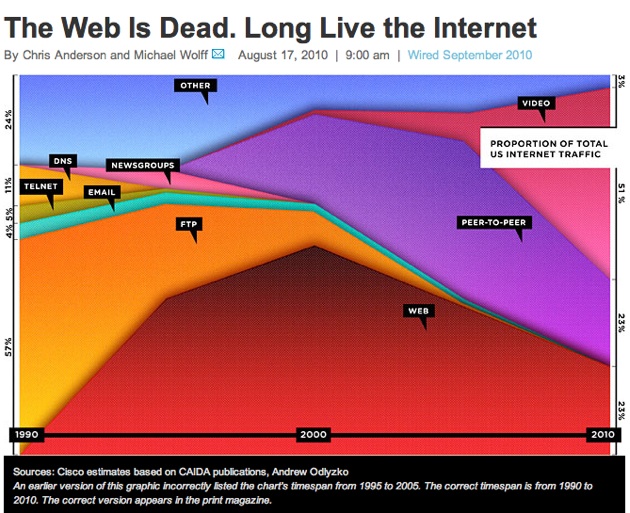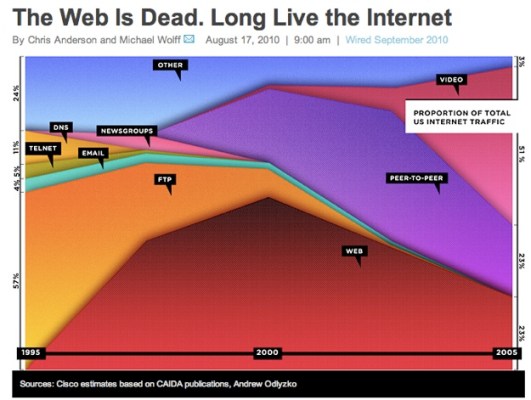
The Web is dead, or at least in decline, declares Wired editor Chris Anderson in the magazine’s September cover story. The article is anchored by the startling infographic above, which shows the proportion of different types of traffic on the Internet. The Web, HTML traffic visible though a browser, is only about a quarter (23%) of the overall traffic, down from about half a decade ago. It’s been pushed down by peer-to-peer (23%), video (51%), and other types of apps which use the Internet for transport but are not browser-based. It’s not clear what exactly Wired is counting as video, but presumably it is not all of the Flash video on YouTube which is very much part of the Web.
Setting aside whether Wired massaged the numbers to make its chart look pretty, Anderson’s larger point is that increasingly we are consuming information via apps other than the browser. He writes:
Over the past few years, one of the most important shifts in the digital world has been the move from the wide-open Web to semiclosed platforms that use the Internet for transport but not the browser for display. It’s driven primarily by the rise of the iPhone model of mobile computing, and it’s a world Google can’t crawl, one where HTML doesn’t rule. And it’s the world that consumers are increasingly choosing, not because they’re rejecting the idea of the Web but because these dedicated platforms often just work better or fit better into their lives (the screen comes to them, they don’t have to go to the screen).
That may be true for now, but don’t count the browser out just yet. These shifts happen in waves. First the browser took over everything, then developers wanted more options and moved to apps (desktop and mobile), but the browser will eventually absorb those features, and so the leapfrogging continues. The ubiquity of the browser overcomes most of its technical deficiencies. Even in mobile, people will become overwhelmed by apps and the browser will make a comeback.
Update: Wired had the wrong timeline on its initial graphic. I’ve replaced with a corrected version above. The data comes from Cisco’s Visual Networking Index, and as I suspected, YouTube videos are not included as part of the Web, they’ve confirmed with me, but rather are lumped into “video” with Skype video calls and Netflix streaming movies. I think that is misleading. Anything you can watch in a browser (like YouTube clips or Netflix movies) should be considered part of the Web, even if it is through a Flash player. The Skype video calls, however, I would count separately since those are watched and transmitted through a separate P2P desktop client. I am sure if you included all of the Web video as part of the Web traffic in the chart, the Web would not look like it is declining at all. That’s right, the Web lives!
